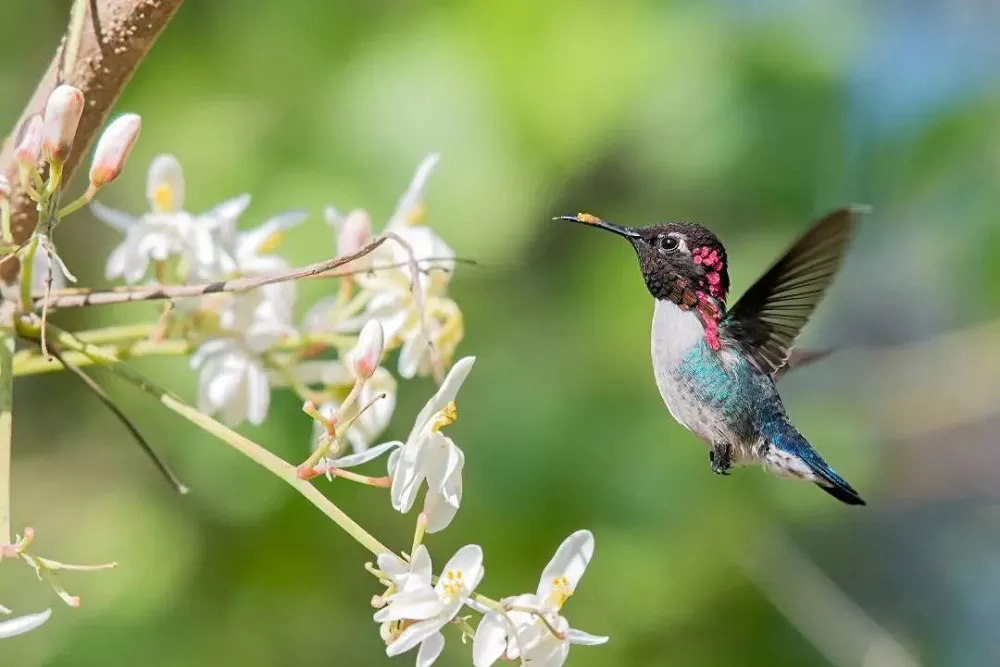Hummingbirds are some of the most fascinating birds in the world, and the bee hummingbird is no exception. The bee hummingbird, also known as the Helena hummingbird or the zunzuncito, is the smallest known bird species in the world. In this article, we will explore what the bee hummingbird looks like and some of its unique characteristics.
Size and Physical Appearance
The bee hummingbird is tiny, measuring only about 2.25 inches (5.7 cm) in length and weighing just 0.07 ounces (2 grams). Its wingspan is approximately 2.75 inches (7 cm). It is so small that it is often mistaken for a bee or a large insect. This is where its common name comes from.
The male and female bee hummingbirds have distinct differences in their physical appearance. The male bee hummingbird has metallic green feathers on its back and crown, while its throat is a bright ruby-red color. It has a black bill, which is slightly curved downwards. The female bee hummingbird, on the other hand, has duller colors with green on its upperparts and white on its underparts. Its bill is also straighter and longer than that of the male.
The bee hummingbird has a slender, streamlined body that is perfectly suited for flight. Its wings beat at an incredible rate of up to 80 times per second, allowing it to hover in mid-air and fly forwards, backwards, and even upside down. Its tail feathers are forked and fan out when it hovers, creating a distinctive sound that is similar to a bee’s buzzing.
Habitat and Range
The bee hummingbird is native to Cuba and is found in the island’s forests, gardens, and parks. It prefers areas that are rich in nectar-producing flowers and has been known to visit over 150 different types of plants for food. The bee hummingbird is a non-migratory species, which means that it stays in Cuba year-round.
Behavior and Diet
The bee hummingbird is a solitary bird that spends much of its time alone or with a mate during breeding season. It is an active bird that spends most of its day searching for food. Its diet consists mainly of nectar from flowers, but it also eats insects and spiders when they are available.
To feed, the bee hummingbird hovers in front of a flower and extends its long, thin bill into its center. The bird’s tongue is long and split at the end, allowing it to scoop up nectar and insects. The bee hummingbird also has a high metabolism and needs to consume almost half of its weight in nectar every day to survive.
Breeding and Reproduction
The bee hummingbird breeding season typically runs from March to June. During this time, male bee hummingbirds will perform elaborate courtship displays to attract females. These displays involve flying back and forth in front of a female while making chirping sounds with their wings.
Once a female has been chosen, the male will perform a complex aerial dance around her while she perches on a branch. After mating, the female will build a tiny nest out of cobwebs, lichens, and plant fibers. She will lay two eggs that are roughly the size of small peas. Both the male and female will take turns incubating the eggs and caring for the hatchlings until they fledge.
Conservation Status
Despite being the smallest bird in the world, the bee hummingbird is not considered endangered. However, its population is decreasing due to habitat loss and fragmentation caused by deforestation and urbanization. The bee hummingbird is also threatened by predation and competition from introduced species such as the honeybee.
Efforts are being made to conserve the bee hummingbird’s habitat through the creation of protected areas and the promotion of sustainable land use practices. The bird is also a symbol of Cuban culture and is featured on the country’s currency.
Conclusion
The bee hummingbird is a remarkable bird that is well-suited for its environment. Its small size, unique physical appearance, and incredible flight capabilities make it a fascinating species to study. Although not considered endangered, the bee hummingbird does face threats from habitat loss and fragmentation, highlighting the need for conservation efforts to ensure that this tiny bird continues to thrive in the wild.
Related topics:
- What does a Bee Hummingbird eat?
- 7 Fun Facts About Hummingbirds: You Must Be Interested
- How To Attract Hummingbirds, 5 Effective Methods
- The Bee Hummingbird: The World’s Smallest Bird


 Facebook
Facebook  Instagram
Instagram  Youtube
Youtube 